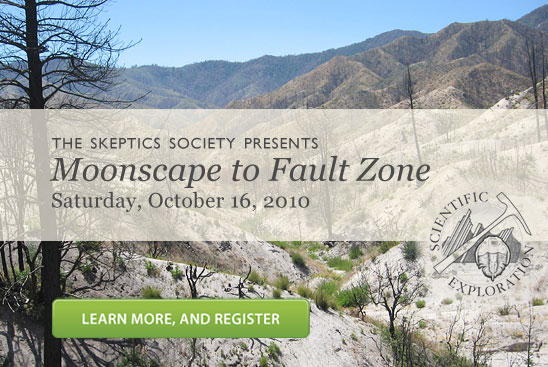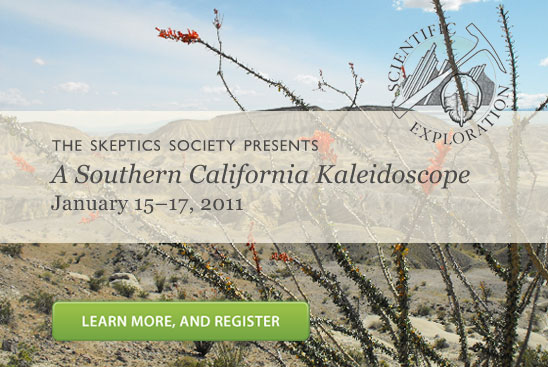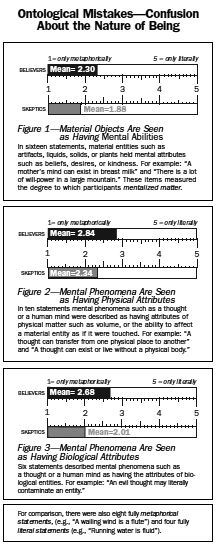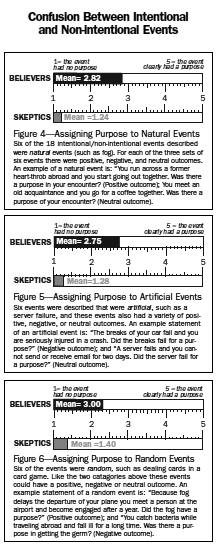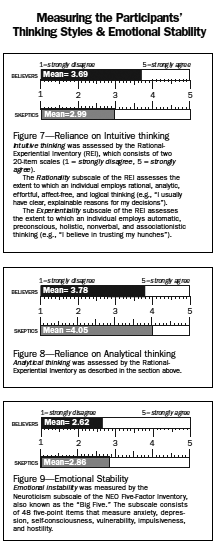In this week’s eSkeptic:
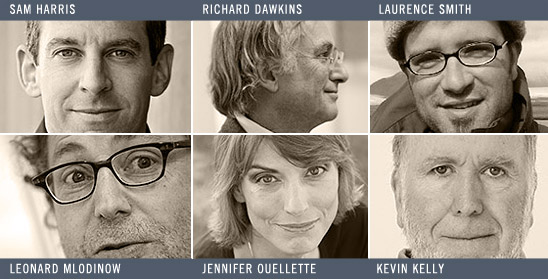
Updated Season of Lectures at Caltech
The lecture by Shing-Tung Yau has been cancelled. In it’s place, we present Dr. Laurence Smith who has forecasted what our planet will be like in the year 2050, distilling his 15 months of research traveling the Arctic Rim with cutting-edge research into four global forces: demographic trends, natural resource demand, climate change, and globalization. Also, Naomi Oreskes won’t be able to make it to lecture this Sunday. Erik Conway will deliver the lecture himself.
IMPORTANT TICKET UPDATE: Tickets for the Dawkins’ and Harris’ lectures go on sale on September 13, 2010 (previously announced as September 7). Please do not call Caltech before September 13, 2010.
Lecture this Sunday…
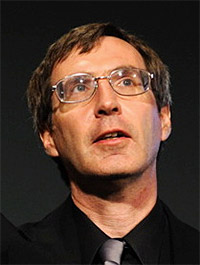
Merchants of Doubt: How a Handful of Scientists Obscured the Truth on Issues from Tobacco Smoke to Global Warming
with Erik M. Conway
Sunday, September 12, 2010 at 2 pm
ERIK CONWAY tells an important story about the misuse of science to mislead the public on matters ranging from the risks of smoking to the reality of global warming. The people he accuses are themselves scientists — mostly physicists, former cold warriors who now serve a conservative agenda, and vested interests like the tobacco industry. And he name names, documenting their involvement in such issues as acid rain, the dangers of smoking and secondhand smoke, the ozone hole, global warming, the Strategic Defense Initiative, and the banning of DDT. These scientists aimed to sow seeds of public doubt on matters of settled science by casting aspersions on the science and the scientists who produce it.
Followed by…
- JENNIFER OUELLETTE (Sept. 26 @ 2 pm, Baxter Lecture Hall)
The Calculus Diaries: How Math Can Help You Lose Weight,
Win in Vegas, and Survive a Zombie Apocalypse - RICHARD DAWKINS (Wed. Oct. 6 @ 8 pm, Beckman Auditorium)
The Greatest Show on Earth: The Evidence for Evolution
Order tickets ($10/$15) in advance starting Sept. 13 - SAM HARRIS (Oct. 24 @ 2 pm, Beckman Auditorium)
The Moral Landscape: How Science can Determine Human Values
Order tickets ($10/$15) in advance starting Sept. 13 - KEVIN KELLY (Nov. 7 @ 2 pm, Baxter Lecture Hall)
What Technology Wants - SHING-TUNG YAU CANCELLED.
- LAURENCE SMITH NEWLY ADDED (Nov. 21 @ 2 pm, Baxter Lecture Hall)
The World in 2050: Four Forces Shaping Civilization’s Northern Future - LEONARD MLODINOW (Dec. 5 @ 2 pm, Baxter Lecture Hall)
The Grand Design
Ticket Information for Baxter Lecture Hall
Tickets are first come first served at the door. Seating is limited. $8. for Skeptics Society members and the JPL/Caltech community, $10. for nonmembers. Your admission fee is a donation that pays for our lecture expenses.
Ticket Information for Beckman Auditorium
$10 Skeptics Society members/Caltech/JPL community; $15 everyone else. Tickets may be purchased in advance beginning Sept. 13, 2010 through the Caltech ticket office at 626-395-4652 or at the door. Ordering tickets ahead of time is strongly recommended. The Caltech ticket office asks that you do not leave a message. Instead call between 12:00 and 5:00 Mon.–Fri.
In this week’s eSkeptic, we present an article from the archives of Skeptic magazine, volume 13, number 1 in which Marjaana Lindeman & Kia Aarnio offer a new and integrative model that aims to explain superstition, magical thinking, and paranormal beliefs.
Dr. Marjaana Lindeman is a researcher, lecturer, and the vice head of the Department of Psychology in the University of Helsinki, Finland. Her research and teaching interests focus on scientific and everyday thinking, and especially on the psychology of believing in paranormal phenomena.
Kia Aarnio is finishing her Ph.D. thesis at the Department of Psychology in the University of Helsinki. Her dissertation will deal with the questions on superstitious (magical, paranormal) thinking and its relationships to religiosity, education, and information processing.

The Origin of Superstition, Magical Thinking, and Paranormal Beliefs
(an integrative model)
by Marjaana Lindeman & Kia Aarnio
In his always quirky but usually insightful look into the human condition, comedian Woody Allen once remarked: “There is no question that there is an unseen world. The problem is how far it is from midtown and how late is it open?”1
In point of fact, the majority of people accept as a given that an unseen world of paranormal powers exists, and all that remains is for us to discover the details of its workings. Superstition and magical thinking are the core cognitions that drive belief in the paranormal. Over 40% of Americans, for example, believe in devils, ghosts, and spiritual healing.2 Most social scientists do not bother trying to understand why people believe in the paranormal, while many psychologists have characterized superstitious and magical thinking as a problem for which there is no ready explanation,3 or as “a label for a residual category — a garbage bin filled with various odds and ends that we do not otherwise know what to do with.”4
Skeptics, of course, have not ignored superstitions and magical beliefs, and there exist today several international magazines, regular conferences, and dozens of excellent books that attempt to both explain the paranormal as well as understand why people believe in it. Explanations have ranged from personality traits, psychological motivation, and flawed cognition, to emotional instability, demographics, and social influences.5 From the purely scientific perspective of experimental psychology, however, our overall understanding of this area has yet to be adequately described and explained. This paper presents a new and integrative model that explains superstition, magical thinking, and paranormal beliefs.
The Need for a Conceptual Model
One of the primary problems facing a scientist studying superstition, magical thinking, and paranormal beliefs is defining what precisely the field entails. There is little agreement on how these terms should be defined, outside of simply providing specific examples of each, and it is not clear how (or if ), the constructs of “superstition,” “magical thinking,” and “paranormal (supernatural)” beliefs differ from each other, or how they differ from obviously false beliefs (e.g., “whales are fish”). Consequently, there is a strong need for a conceptual model that clarifies the meaning of magical, paranormal, and superstitious beliefs, and explains why rational Western people still believe in things that seem so irrational. This study provides an initial step in this direction. Here we will offer new theoretical propositions, which will define the constructs and offer criteria for their application. We will also analyze whether our definition can be empirically justified.
Among the most influential definitions of magical thinking are the laws of sympathetic magic outlined in the early days of anthropology.6 The law of contagion holds that things that have once been in contact with each other continue to act upon each other at a distance after the physical contact has been severed. The law of similarity holds that superficial resemblance indicates, or causes, deep resemblance. During the last two decades, researchers have conducted a series of path-breaking studies that revealed how these laws manifest themselves among well-educated Western adults.7 However, the laws of sympathetic magic are neither intended nor sufficient to cover all superstitious, magical and paranormal beliefs. Moreover, as the researchers themselves note, the distinction between the laws of magical thinking and reality — for example between magical contagion and microbial contamination and between magical similarity and vaccination — can be subtle and ambiguous.8
Other authors have defined superstitious and magical beliefs more widely as false cognitions — for example as limitations in cognitive processing,9 beliefs that are barely articulated,10 tenets founded on ignorance,11 and as causal beliefs that by conventional standards are invalid.12
Simply defining superstitious beliefs as erroneous still leaves us with an important question: how do they differ from other unfounded beliefs? Today most scientists agree with Charles Broad’s definition of the paranormal as a phenomenon that violates the fundamental and scientifically founded principles of nature.13 Using this as our starting point, we propose that the key difference between superstitious, magical, or paranormal beliefs, and other kinds of unfounded beliefs can be found by applying a concept from studies on children’s cognitive development known as core knowledge.
Core Knowledge and Superstition
According to developmental psychologists, three types of knowledge determine a child’s understanding of the world: intuitive physics, intuitive psychology, and with certain reservations, intuitive biology.14 Part of this knowledge is characterized as core knowledge, that is, knowledge that children learn without instruction; for example, intuitive comprehension of physical, biological, and psychological entities as well as different forms of processes in which these entities engage. Core knowledge — developed by preschool age — provides the foundation for further development. It is based on what psychologists call domain specialized learning mechanisms, or modules, which evolved in response to our Paleolithic environment.15
Developmental studies show that core knowledge of physical entities includes the understanding that the world is composed of material objects which have volume and an independent existence in space.16 Core knowledge of biological entities represents a species-typical adaptation to the problem of food selection and illness avoidance.17 Even if cultures lack a scientific understanding of disease transmission they still possess an intuitive understanding of it through their core knowledge.18 Similarly, 4-year-olds know that abnormal behaviors are not contagious,19 and they can discriminate between contaminated and safe substances despite a lack of visible evidence.20 Core knowledge of psychological entities includes the understanding that animate beings are intentional agents which have a mind. By the middle of the second year children understand that animate beings can reciprocate actions and have a capacity to move and initiate actions without external force.21 In addition, small children understand that the contents of mind — thoughts, beliefs, desires, and symbols — are nonmaterial and mental, and that they do not contain the properties they stand for.22 For example, 3- and 4-year-old children understand that the thought of a dog does not have the material properties of a dog,23 and that the roads in a map do not need to be wide enough for cars.24
How is it, then, that intuitively rational children grow up to become superstitiously irrational adults? One explanation for superstition is that a child’s intuitive core knowledges of physical, biological, and psychological entities can become conflated with each other and applied across categories. As a consequence, ordinary entities and processes in the natural domain become extraordinary entities and processes in integrated supernatural domains. This fusion leads people to conclude that mental contents have the attributes of physical or animate entities, resulting in the possibility that a thought can touch objects (psychokinesis) or move by itself (telepathy). For example, when contagion and healing are attributed to psychological phenomena, we find that Hitler’s personality can spread into his sweater,25 and that a healer can cure someone at a distance by force of his or her thoughts. In this other world, entities with good and bad minds such as angels and devils have independent existences and operate as animate objects by moving and initiating actions without external force.
In the magical world, mental qualities like intention are attributed to physical and biological events — such as when rain dancers try to influence the atmosphere, or when Las Vegas craps shooters roll the dice gently to coax a low number or vigorously to encourage a high number, in the belief that they can will a change in the physical environment. We also find that the concept of “force” in lay physics can be seen by some as a living and intentional entity. For example, feng shui holds that incorrect arrangement of home furnishings can block a “vital force” which might make a household susceptible to crime or divorce; and astrologers suggest that planets emit living forces which push and pull human beings in a purposeful way that affects personality and well-being. In the magical world of superstitious thinking, biological and physical processes are no longer seen as nonintentional as they are in the core knowledge world of children. Instead they are seen as having a purpose that is directed toward specific goals — goals that can be influenced by the nonphysical assertions of outside agents.26
Defining Superstitious, Magical, and Paranormal Beliefs
Based on this research on core knowledge, we define superstitious, magical, and paranormal beliefs as category mistakes where the core attributes of mental, physical, and biological entities and processes are confused with each other. Of course, not all superstitions are category mistakes. For example, many adults regard physical force as a material substance, which it is not.27 What differentiates other category mistakes from superstitions is that in superstitions the category mistakes always include a confusion of core knowledge. Also, category mistakes can be perceived as superstitions only insofar as the statements are believed to be literally true. Thus, metaphorical and allegorical expressions that deliberately confuse the properties are not superstitions (e.g., “A well-functioning memory is a goldmine”).
While preschool children understand a surprising amount about physical, biological, and psychological phenomena, at first they make the same category mistakes that can be found in superstitions.28 However, equating adults’ superstitions with small children’s misconceptions does not imply that superstitious individuals are cognitively at the level of small children. The definition should be understood through the basic tenet of dual-process theories that people have two modes of processing information — intuition and logic — which rely on different databases and operate using different rules.29 According to the dualprocess theories, as children mature analytical processes and rational knowledge do not replace intuitive processes and contents. Rather, both types of processes and knowledge exist and develop throughout one’s life, and therefore two conflicting beliefs can coexist in an adult’s mind, one rational and justifiable (e.g., “Death is final”), the other operating more automatically and being more resistant to logical arguments (e.g., “The soul continues to exist though the body may die”).
Testing the Hypothesis
To investigate whether our new conceptualization was warranted, we hypothesized that in comparison to skeptical individuals, superstitious individuals should more often assign mental attributes to physical and biological entities and material attributes to mental entities, and confuse intentional processes with non-intentional processes. We also hypothesized that various types of superstitious, magical, and paranormal beliefs are similarly related to ontological confusions that are, in turn, positively related to a tendency to rely on intuitive thinking. Finally, we expected that ontological confusions and intuitive thinking are more important correlates of superstitions, magical and paranormal beliefs than the two other correlates that have repeatedly been suggested to account for the beliefs — lower rational thinking and emotional instability.
To test our hypothesis, 239 Finnish volunteers participated in the study (recruited from a larger population of 3,261 individuals who participated in a study on superstition the year before): 96 female and 27 male skeptics were compared to 88 female and 28 male superstitious individuals. We sent an invitation to those whose overall superstition scores were among the upper or lower 10% for their gender. (The groups were balanced for gender because in the earlier study women (M = 2.16) had higher superstition scores than men (M = 1.94), a difference significant at the .001 level. Their age range was 16–47 with a mean of 24.2 years. The great majority (94%) were full-time students who represented a wide variety of disciplines, including the natural, behavioral, medical, and social sciences, and technology, business, trade, and services.)30
To test our hypothesis about ontological confusions, we constructed a measure based on one developed by Chi and her associates.31 First, we examined the participants’ conceptions of properties of different ontological entities by 34 statements in which attributes of one ontological category were assigned to another one. The participants were asked whether they understood the statements as metaphorically or literally true (1 = only metaphorically, 5 = only literally). (Figures 1–3.)
In 16 of the statements, material entities (artifacts, liquids, solids, plants) held mental attributes (e.g., beliefs, desires, kindness). For example: “Old furniture remembers things about the past” and “When summer is warm, flowers want to bloom.” These items measured the tendency to mentalize matter. Ten of the statements assessed physicalizing the mental. They described mental phenomena such as a thought or human mind that was said to have the attributes of physical matter such as volume, or the ability to affect a material object as if by touch. For example: “A human mind lives on after the person has died.” Six statements assessed biologizing the mental. They described mental phenomena (a thought, a human mind) said to have the attributes of biological entities (e.g., is living, can be contaminated). For example: “An evil thought may literally contaminate an entity.” For comparison, there were also eight fully metaphorical statements. (e.g., “A wailing wind is a flute”) and four fully literal statements (e.g., “Running water is fluid”).
Confusion between intentional and non-intentional events was analyzed by giving the participants descriptions of 18 non-intentional events that lead to personally relevant outcomes, and by asking whether they saw purpose in that event (1 = the event had no purpose, 5 = the event clearly had a purpose). The 18 statements included three types of non-intentional events. Six of the events were random (e.g., dealing cards in a card game), six were artificial (e.g., a server failure), and six were natural events (e.g., fog). For each set of six events, positive, negative, and neutral outcomes were described.
The positive and negative outcomes were derived from the Life Experience Survey.32 An example statement of a random event with a negative outcome is: “When you play cards you get only clubs and spades and therefore run up large debts. Did you get those cards for a purpose?” An example statement of an artificial event with a positive outcome includes: “Your brakes fail, causing damage to a stranger’s car. You end up marrying the stranger. Did the brakes fail for a purpose?” An example statement of natural events with a neutral outcome is: “A lightning strike topples a big tree in your garden, but causes no other harm. Did the lightning have a purpose?” For comparison, there were also four statements, which described true intentional events (e.g., a kiss, running a race, bullying) with positive, neutral, and negative outcomes (e.g., a beginning of a romantic relationship, reduced working ability).
The level of belief in the paranormal by participants had been measured in an earlier study through the Revised Paranormal Belief Scale (RPBS),33 which was a slightly revised version of the most commonly used measure of superstitious, magical, paranormal and religious beliefs.34 Because the items on the RPBS cover only some aspects of superstitious and magical beliefs, it was supplemented with a number of items to cover a wider spectrum of beliefs. The 55 items were measured on a five-point rating scale (1 = strongly disagree, 5 = strongly agree) and included: entities, such as witches, extraordinary life forms, and extraterrestrial life (e.g., “Ghosts exist”); psi power, such as telepathy, spiritualism, precognition, and psychokinesis (e.g., “A person’s thoughts can influence the movement of a physical object”); religious beliefs (e.g., “I believe in God”); luck, rituals, and amulets (e.g., “Amulets, for instance a specific piece of jewelry, bring good luck”); astrology (e.g., “The position of the stars at the time of birth influences personality”); feng shui (e.g., “Furnishing according to the principles of feng shui balances your environment and thus affects your health and success in a positive way”). Finally, to measure overall superstition a mean score of all the items was used.
Analytical and intuitive thinking were assessed by the Rational-Experiential Inventory (REI), which consists of two 20-item scales (1 = strongly disagree, 5 = strongly agree).35 The Rationality subscale of the REI assesses the extent to which an individual employs rational, analytic, effortful, affect-free, and logical thinking (e.g., “I usually have clear, explainable reasons for my decisions”). The Experientiality subscale of the REI assesses the extent to which an individual employs automatic, preconscious, holistic, nonverbal, and associationistic thinking (e.g., “I believe in trusting my hunches”).
Emotional instability was measured by the Neuroticism subscale of the Finnish version of the NEO Five-Factor Inventory, also known as the “Big Five.”36 The subscale consists of 48 five-point items (1 = strongly disagree, 5 = strongly agree), which measure anxiety, depression, self-consciousness, vulnerability, impulsiveness, and hostility.
Results of the Study
As would be expected based on our hypothesis, there are ontological differences in belief between the believers and the skeptics in our sample: believers mentalized matter more than skeptics (Figure 1),37 believers physicalized the mental more than skeptics (Figure 2),38 and also believers biologized the mental more than skeptics (Figure 3).39 By contrast, believers did not differ from skeptics when they assessed the truth of purely literal statements or the purely metaphorical statements.
In addition, believers also assigned more purpose to natural events than skeptics (Figure 4),40 more purpose to artificial events than the skeptics (Figure 5),41 and more purpose to random events than the skeptics (Figure 6).42 By contrast, determining that intentional events had purpose was recognised to an equal degree by both the believers and the skeptics.
The results also showed that believers relied more on intuitive thinking than skeptics (Figure 7),43 but less on analytical thinking than skeptics (Figure 8).44 And believers were emotionally less stable than skeptics (Figure 9).45 There were no gender differences between the groups.
What the Results Mean
In the past, scientists have treated beliefs in superstition, magic, and the paranormal as both distinct and interrelated phenomena, and they have not been consistent in defining these concepts. Our goal in this study was to present a unified conceptual framework where the concepts were differentiated from other unfounded beliefs and defined identically as an ontological confusion between the core attributes of mental, physical, and biological entities and processes. In addition, we examined whether superstitious individuals confuse the attributes of ontological categories, as the definition suggests.
The results supported our hypothesis. Compared with skeptics, superstitious believers assigned more physical and biological attributes to mental phenomena. Significantly more than skeptics, believers held such notions as a mind that can physically affect objects and an evil thought may literally contaminate an entity. Superstitious individuals also assigned more mental attributes to water, furniture, rocks, and other material things than skeptics did, and accepted that entities like these may — literally, not only metaphorically — have psychological properties such as desires, knowledge, or a soul. In particular, superstitious individuals saw natural, random and artificial (i.e., non-intentional) events like fog or a computer failure as having a purpose when the processes that led to episodes ended up having a personally relevant outcome such as a marriage. The believers did not, however, differ from the skeptics when they assessed the actual truth of purely literal or purely metaphorical statements, or the purposefulness of truly intentional acts like kissing. The results also showed that various manifestations of the beliefs in such phenomena as astrology, feng shui, and ESP were associated with ontological confusions and with higher intuitive thinking, and — albeit only slightly — to lower analytical thinking and emotional instability. These results support the argument that superstitions and other paranormal beliefs arise from the intuitive system and not from a failure of the analytical system, and are in line with the earlier findings that people who rely more on intuitive thinking hold more superstitions than others.46 In short, our results are in line with the theory that ontological confusions are defining properties of superstitions, magical, and paranormal beliefs.
In addition, our new definition of superstition as a category mistake of core knowledge enables us to identify how superstitions differ from other unfounded beliefs. Accordingly, many beliefs that have previously been regarded as paranormal, magical, or superstitious are simply unsubstantiated beliefs, not superstitions. These include, for example, belief in graphology or biorhythms. Likewise, beliefs obeying the laws of contagion and similarity are here regarded as superstitions only insofar as the idea of contagion is stretched beyond the biological domain and similarity is used to draw inferences about entities from different ontological domains. Thus, disgust towards a piece of clothing worn by a sick person is not a superstition, whereas disgust towards clothes worn by Hitler is. Similarly, reasoning that whales are fish because of similar appearance and habitats is simply a false belief, whereas a belief that needles stuck in a doll cause pain in the person the doll represents is a superstition.
The confusion of core knowledge is the common denominator for a wide range of superstitions, magical and paranormal beliefs, ranging from primitive animism to modern feng shui, and from children’s beliefs that the moon is an animate being to educated adults’ beliefs in astrology. It is our hope that this new conceptualization will enable researchers to make more elaborated theoretical statements regarding superstition. For example, one theory holds that superstitions are a form of people’s search for causal explanations and organizing the world in a meaningful and consistent fashion to impose order and predictability on it. However, because the same reasons also apply to numerous other endeavors, such as science, the explanatory power of these statements for superstition has been weak.
The present study suggests that future studies on superstition — and theories to explain them — might benefit from addressing intuitive thinking and its knowledge base. Subsequent efforts may provide more powerful indications that superstitious individuals’ knowledge about the world is inaccurate in that their early, as yet undeveloped intuitive conceptions about psychological, biological, and physical phenomena have retained their power and co-exist with later acquired rational knowledge.
In addition, future research might attempt to analyze whether superstitions can be understood in terms of a common essence. For example, children classify members into categories based on their essences (e.g., dogs and cats are in the same category — animals; toys and dogs are in different categories).48 Similarly, anthropologists have suggested that a central theme in the versatile magical beliefs found among the Hua people in New Guinea is the vital essence they call nu.49 This common essence parallels the view that in superstitions, there is typically an interconnected cosmos, a fundamental relation between a part and a whole where, for example, individual humans are connected to the universe, and a single event is linked to the future.50 Thus, we suggest that confusion between the core properties of ontological categories implies a notion of a common essence between the categories, and this leads to thinking in terms of connections and undivided totalities. It is this core confusion that we believe leads to the belief in superstition, magic, and the paranormal.
Acknowledgments: We thank Tarmo Toikkanen and Marieke Saher for assistance.
This study was supported by a grant from the Academy of Finland (200828).
References
- Allen, W. 1980. Complete Prose. London: Picador, 15.
- National Science Foundation 2002. Science and Engineering: Indicators 2002. Science and Technology: Public Attitudes and Public Understanding. Science Fiction and Pseudoscience. Retrieved March 17, 2005, from: http://www.nsf.gov/sbe/srsseind02/c7/c7s5.htm. Rice, T. 2003. “Believe it or Not: Religious and Other Paranormal Beliefs in the United States.” Journal for the Scientific Study of Religion, 42, 95–106.
- Campbell, C. 1996. “Half-Belief and the Paradox of Ritual Instrumental Activism: A Theory of Modern Superstition.” British Journal of Sociology, 47, 151–166.
- Nemeroff, C., and Rozin, P. 2000. “The Makings of the Magical Mind. The Nature and Function of Sympathetic Magical Thinking.” In K. Rosengren & C. Johnson & P. Harris Eds., Imagining the Impossible: The Development of Magical, Scientific, and Religious Thinking in Contemporary Society, pp. 1–34. Cambridge: Cambridge University Press, 1.
- Vyse, S. A. 1997. Believing in Magic: The Psychology of Superstition. New York: Oxford University Press. Zusne, L., & Jones, W. H. 1989. Anomalistic Psychology: A Study of Magical Thinking 2nd ed. Hillsdale, NJ: Erlbaum. Sagan, C. 1996. Demon-Haunted World. New York: Random House. Shermer, M. 1997. Why People Believe Weird Things. New York: W. H. Freeman.
- Frazer, J. G. 1922/1963. The Golden Bough. A Study in Magic and Religion. New York: Macmillan. Tylor, E. B. 1871/1974. Primitive Culture: Research into the Development of Mythology, Philosophy, Religion, Art, and Custom. New York: Gordon Press.
- Rozin, P., Millman, L., & Nemeroff, C. 1986. “Operation of the Laws of Sympathetic Magic in Disgust and Other Domains.” Journal of Personality and Social Psychology, 50, 703–712.
- Nemeroff, C., and Rozin, C. 2000, op cit.
- Shweder, R. A. 1977. “Likeness and Likelihood in Everyday Thought: Magical Thinking in Judgments about Personality.” Current Anthropology, 18, 637–658.
- Campbell, C. 1996, op cit.
- Padgett, V. R., & Jorgenson, D. O. 1982. ”Superstition and Economic Threat: Germany, 1918–1940.” Personality and Social Psychology Bulletin, 8, 736–741.
- Brugger, P., & Graves, R. E. 1997. “Testing vs. Believing Hypotheses: Magical Ideation in the Judgment of Contingencies.” Cognitive Neuropsychiatry, 2, 251–272.
- Broad, C. D. 1953. Religion, Philosophy, and Psychical Research. New York: Harcourt & Brace.
- Goswami, U. Ed.. 2002. Blackwell Handbook of Childhood Cognitive Development. Oxford: Blackwell. Wellman, H. M., & Gelman, S. A. 1992. “Cognitive Development: Foundational Theories of Core Domains.” Annual Review of Psychology, 43, 337–375. Wellman, H. M., & Gelman, S. A. 1998. “Knowledge Acquisition in Foundational Domains. In D. Kuhn & R. S. Siegler Eds., Handbook of Child Psychology. Cognition, Perception, and Language, Vol. 2, pp. 523–573. New York: Wiley.
- Carey, S. 1996. “Cognitive Domains as Modes of Thought.” In D. Olson & N. Torrance Eds., Modes of Thought pp. 187–215. Cambridge: Cambridge University Press. Leslie, A. M. 1994. “ToMM, ToBY, and Agency: Core Architecture and Domain Specificity.” In L. A. Hirschfeld & S. A. Gelman Eds., Mapping the Mind. Domain Specificity in Cognition and Culture, pp. 119–148. Cambridge: Cambridge University Press. Spelke, E. 2000. “Core Knowledge.” American Psychologist, 55, 1233–1232.
- Carey, S., & Spelke, E. 1994. “Domain-Specific Knowledge and Conceptual Change.” In L. A. Hirschfeld & S. A. Gelman Eds., Mapping the Mind. Domain Specificity in Cognition and Culture, pp. 169–200. Cambridge: Cambridge University Press.
-
Rozin, P. 1990. “Development in the Food Domain.” Developmental Psychology, 26, 555–562. Rozin, P., & Fallon, A. E. 1987. “A Perspective on Disgust.” Psychological Review, 94, 23–41.
Rakison, D., & Poulin-Dubois, D. 2001. “Developmental Origin of the Animate-Inanimate Distinction.” Psychological Bulletin, 127, 209–228.
- Kalish, C. 1999. “What Young Children’s Understanding of Contamination and Contagion Tells us About Their Concepts of Illness.” In M. Siegal & C. C. Peterson Eds., Children’s Understanding of Biology and Health, pp. 99–130. Cambridge: Cambridge University Press.
- Keil, F. C. 1994. “The Birth and Nurturance of Concepts by Domains: The Origins of Concepts of Living Things.” In L. A. Hirschfeld & S. A. Gelman Eds., Mapping the Mind. Domain Specificity in Cognition and Culture, pp. 234–254. Cambridge: Cambridge University Press.
- Fallon, A. E., Rozin, P., & Pliner, P. 1984. “The Child’s Conception of Food: The Development of Food Rejections with Special Reference to Disgust and Contamination Sensitivity.” Child Development,55, 566–575.
- Carey, S., & Spelke, E. 1994, op cit.
- Johnson, C. N. 2000. “Putting Different Things Together: The Development of Metaphysical Thinking.” In K. S. Rosengren & C. N. Johnson & P. L. Harris Eds., Imagining the Impossible. Magical, Scientific and Religious Thinking in Children, pp. 179–211. Cambridge: Cambridge University Press. Leslie, A. M., Friedman, O., & German, T. P. 2004. “Core Mechanisms in ‘Theory of Mind’.” Trends in Cognitive Science, 8, 528–533. Piaget, J. 1929/1951. The Child’s Conception of the World. London: Routledge and Kegan. Wellman, H. M. 2002. “Understanding the Psychological World: Developing a Theory of Mind.” In U. Goswami Ed., Blackwell Handbook of Childhood Cognitive Development, pp. 167–187. Oxford: Blackwell.
- Harris, P. L., Brown, E., Marriot, C., Whithall, S., & Harmer, S. 1991. “Monsters, Ghosts and Witches: Testing the Limits of the Fantasy-Reality Distinction in Young Children.” British Journal of Developmental Psychology, 9, 105–123.
- DeLoache, J. S. 2002. “Early Development of the Understanding and Use of Symbolic Artifacts.” In U. Goswami Ed., Blackwell Handbook of Childhood Cognitive Development, pp. 207–226. Oxford: Blackwell.
- Nemeroff, C. J. 1995. “Magical Thinking About Illness Virulence: Conception of Germs From ‘safe’ versus ‘dangerous’ others.” Health Psychology, 14, 147–151.
- Bering, J. M. 2003. “Towards a Cognitive Theory of Existential Meaning.” New Ideas in Psychology, 21, 101–120. Kelemen, D. 1999. “Function, Goals and Intention: Children’s Teleological Reasoning About Objects.” Trends in Cognitive Science, 3, 461–468.
- Reiner, M., Slotta, J. D., Chi, M. T. H., & Resnick, L. B. 2000. “Naive Physics Reasoning: A Commitment to Substance-Based Conceptions.” Cognition and Instruction, 18, 1–34.
- Kelemen, D. 1999. “Why are Rocks Pointy? Children’s Preference for Teleological Explanations of the Natural World.” Developmental Psychology, 35, 1440–1452. Rosengren, K. S., Johnson, C. N., & Harris, P. L. Eds. 2000. Imagining the Impossible. Magical, Scientific and Religious Thinking in Children. Cambridge: Cambridge University Press.
- Evans, J. S. B. T. 2003. “In Two Minds: Dual-Process Accounts of Reasoning.” Trends in Cognitive Science, 7, 454–459. Pacini, R., & Epstein, S. 1999. “The Relation of Rational and Experiential Information Processing Styles to Personality, Basic Beliefs, and the Ratiobias Phenomenon.” Journal of Personality and Social Psychology, 76, 972–987. Sloman, S. A. 1996. “The Empirical Case for Two Systems of Reasoning.” Psychological Bulletin, 119, 3–22. Stanovich, K. E., & West, R. F. 2000. “Individual Differences in Reasoning: Implications for the Rationality Debate?” Behavioral and Brain Sciences, 23, 645–726. Sun, R. 2004. “Desiderata for Cognitive Architectures.” Philosophical Psychology, 17, 341–373.
- The recruitment message contained a personal password and a hyperlink to the questionnaire on the Internet. The web survey was implemented as a Java Servlet, running on an Apache web server. Due to incomplete contact information, a total of 14% of the participants of the earlier study were eventually invited to take part. Fifty three percent of them returned a completed questionnaire within the time limit.
- Chi, M. T. H. 1992. “Conceptual Change Within and Across Ontological Categories: Examples From Learning and Discovery in Science.” In R. N. Giere Ed., Cognitive Models of Science, pp. 129–186. Minneapolis, MN: University of Minnesota Press. Chi, M. T. H., Slotta, J. D., & de Leeuw, N. 1994. ”From Things to Processes: A Theory of Conceptual Change for Learning Science Concepts.” Learning and Instruction, 4, 27–43.
- Sarason, J. G., Johnson, J. H., & Siegel, J. M. 1978. ”Assessing the Impact of Life Changes: Development of the Life Experience Survey.” Journal of Consulting and Clinical Psychology, 46, 932–946.
- Tobacyk, J. J. 2004. “A Revised Paranormal Belief Scale.” The International Journal of Transpersonal Studies, 23, 94–98.
- Tobacyk, J., & Milford, G. 1983. “Belief in Paranormal Phenomena: Assessment Instrument Development and Implications for Personality Functioning.” Journal of Personality and Social Psychology, 44, 1029–1037.
- Pacini, R., & Epstein, S. 1999, op cit.
- McCrae, R. R., & Costa, P. T. 1987. “Validation of the Five-Factor Model of Personality Across Instruments and Observers.” Journal of Personality and Social Psychology, 52, 81–90. Pulver, A., Allik, J., Pulkkinen, L., & Hamalainen, M. 1995. ”A Big Five Personality Inventory in Two Non-Indo-European Languages.” European Journal of Personality, 9, 109–124.
- F (1,237) = 16.66, p < 0.001, r2 = 0.07.
- F (1,237) = 26.44, p < 0.001, r2 = 0.10.
- F (1,237) = 34.07, p < 0.001, r2 = 0.13.
- F (1,235) = 197.49, p < 0.001, r2 = 0.46.
- F (1,235) = 169.53, p < 0.001, r2 = 0.42.
- F (1,235) = 200.62, p < 0.001, r2 = 0.46.
- F (1,239) = 97.51, p < 0.001, r2 = 0.29.
- F (1,239) = 14.50, p < 0.001, r2 = 0.06.
- F (1,239) = 9.68, p < 0.01, r2 = 0.04.
- Epstein, S., Pacini, R., Denes Raj, V., & Heier, H. 1996. “Individual Differences in Intuitive-Experiential and Analytical-rational Thinking Styles.” Journal of Personality and Social Psychology, 71, 390–405.
- Malinowski, B. 1948/1992. Magic, Science and Religion. Prospect Heights, Ill.: Waveland Press. Tambiah, S. J. 1990. Magic, Science, Religion, and the Scope of Rationality. Cambridge: Cambridge University Press.
- Gelman, S. A. 2004. “Psychological Essentialism in Children.” Trends in Cognitive Science, 8, 404–409. Johnson, C. N., & Harris, P. L. 1994. “Magic: Special but not Excluded.” British Journal of Developmental Psychology, 12.
- Meigs, A. S. 1984. Food, Sex, and Pollution. A New Guinea Religion. New Jersey: Rutgers University Press.
- Werner, H. 1948. Comparative Psychology of Mental Development. New York: International Universities Press.
Skeptical perspectives on magic, superstition, and the paranormal
-
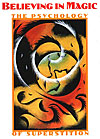 Believing in Magic: The Psychology of Superstition
Believing in Magic: The Psychology of Superstition
(paperback $19.95) by Stuart A. Vyse
-
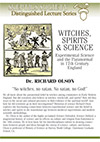 Witches, Spirits & Science: Experimental Science and the Paranormal in 17th Century England
Witches, Spirits & Science: Experimental Science and the Paranormal in 17th Century England
(DVD $23.95) with Dr. Richard Olson
-
 The New Age: Notes of a Fringe Watcher
The New Age: Notes of a Fringe Watcher
(paperback $26) by Martin Gardner
-
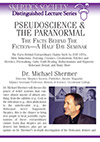 Pseudoscience and the Paranormal: The Facts Behind The Fiction (A Half Day Seminar)
Pseudoscience and the Paranormal: The Facts Behind The Fiction (A Half Day Seminar)
(DVD $23.95) with Dr. Michael Shermer

NEW ON SKEPTICBLOG.ORG
What I Believe (about Markets and Morals)
Although the Skeptics Society is apolitical, Michael Shermer sometimes explores political and economic issues in his blog posts. In this week’s Skepticblog, Michael Shermer replies to his critic: evolutionary biologist and slayer of creationist dragons Jerry Coyne.


